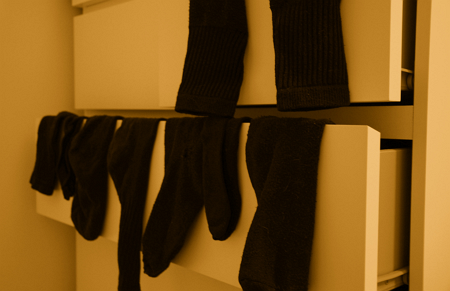One Sock(s), Two Socks, Red Socks, Blue Socks
 A drawer contains red socks and an even number of blue socks. When 2 socks are drawn randomly without replacement, the probability that both of them are red is 50%. What is the fewest possible number of socks in the drawer?
A drawer contains red socks and an even number of blue socks. When 2 socks are drawn randomly without replacement, the probability that both of them are red is 50%. What is the fewest possible number of socks in the drawer?
The answer is 21.
This section requires Javascript.
You are seeing this because something didn't load right. We suggest you, (a) try
refreshing the page, (b) enabling javascript if it is disabled on your browser and,
finally, (c)
loading the
non-javascript version of this page
. We're sorry about the hassle.
The first thing to note here is that " red socks " is mentioned in the plural. In order for there to be a 50:50 chance, there needs to be a chance to actually draw a red sock, so we know there needs to be 2 or more red socks. Nextly, we only care about the probably of drawing a red sock both times. This eliminates the need to calculate side lines where one pulls a red sock then a blue sock, or vice versa. Lastly, we should be cautious that there might be socks of other colors in the drawer. But since the question at the end asks for the minimum amount of socks in the drawer, we can eliminate the possibility that other socks are in the drawer. So far we know:
r ≥ 2 , b ≥ 2 , a n d b i s e v e n .
Next up we need an equation for calculating our probability.
Let's say we have 2 red socks and 2 blue socks in the drawer, the minimum case.
The probability of drawing a red sock on the first pull is obviously 50:50 since there's 2 red socks and 4 socks in the drawer. Thus the probability of drawing a red sock on the first pull is r + b r
Nextly, we need a formula for calculating the probability that we draw a red sock both times.
After we draw a red sock the first time, using the formula we just calculated, we need a formula for calculating the probability our second pull is also a red sock. All we do is use the same formula but minus r by 1 since we already pulled a red sock. r − 1 + b r − 1 Now, in order to calculate the probability that both pulls will yield red socks, we simply multiply our formulas together. Thus the probability that both pulls yielded red socks is: ( r + b r ) ( r − 1 + b r − 1 ) . Finally, since we're only interested in the least number of socks in the drawer where the probability is 50:50, we can finally write an equation:
f ( r , b ) = ( r + b r ) ( r − 1 + b r − 1 ) = 2 1
Time to brute force it:
f ( 2 , 2 ) = 0 . 1 6
f ( 3 , 2 ) = 0 . 3
f ( 4 , 2 ) = 0 . 4
f ( 5 , 2 ) = 0 . 4 7 6 1 9 0
f ( 6 , 2 ) = 0 . 5 3 5 7 1 4 2 8 5 7
f ( 6 , 4 ) = 0 . 3
f ( 7 , 4 ) = 0 . 3 8 1 8
f ( 8 , 4 ) = 0 . 4 2
f ( 9 , 4 ) = 0 . 4 6 1 5 3 8
f ( 1 0 , 4 ) = 0 . 4 9 4 5 0 5
f ( 1 1 , 4 ) = 0 . 5 2 3 8 0 9
f ( 1 1 , 6 ) = 0 . 4 0 4 4 1 . . .
f ( 1 2 , 6 ) = 0 . 4 3 1 3 7 . . .
f ( 1 3 , 6 ) = 0 . 4 5 6 1 4 . . .
f ( 1 4 , 6 ) = 0 . 4 7 8 9 4 . . .
f ( 1 5 , 6 ) = 0 . 5
Thus we know the answer is 15 red socks and 6 blue socks.